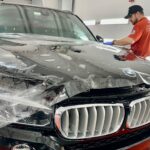Winter driving can be rough on your vehicle’s paint, with threats from road salt, sand, snow, and icy debris. Paint protection film (PPF) is a popular choice to shield against these hazards, yet there are several myths around its effectiveness, especially in winter. Here, we’re setting the record straight and addressing some of the most common PPF myths to help you make informed decisions about your vehicle’s winter protection.
Myth 1: PPF Can’t Withstand Extreme Cold
One common misconception is that PPF will become brittle and crack in extreme cold. While this may have been an issue with early film technologies, modern PPF is designed to be highly resilient. Today’s high-quality PPF is engineered to remain flexible and durable in both extreme cold and heat, protecting your vehicle in any season. Many films also come with self-healing properties, meaning minor scratches or scuffs can disappear when exposed to sunlight or heat.
If you live in a region with freezing winters, choosing a reputable PPF installer and a quality film will ensure that your vehicle’s paint is well-protected, no matter the weather.
Myth 2: PPF Will Peel or Lift in Winter Weather
It’s a common fear that snow, ice, or salt will cause PPF to peel or lift off the car’s surface. In reality, a correctly installed PPF adheres securely to your vehicle’s paint and will not lift or peel under typical winter conditions. Most issues with peeling arise from poor installation, so it’s essential to work with experienced installers who use professional-grade films and follow correct application techniques.
When properly applied, PPF can handle everything winter throws at it, from snow-packed roads to salted highways, without budging.
Myth 3: PPF Yellows or Stains Easily in Winter
Older generations of PPF sometimes yellowed when exposed to UV light or harsh chemicals. However, high-quality modern PPF products have UV protection and are designed to resist staining and yellowing. Additionally, if properly maintained, your PPF will repel winter contaminants like salt and grime, keeping your car looking pristine.
You can also apply ceramic coatings over PPF to enhance its resistance to contaminants. Together, PPF and ceramic coatings provide robust protection against winter weather while maintaining a clear, transparent finish.
Myth 4: It’s Harder to Clean a Car with PPF in Winter
PPF actually makes cleaning your vehicle easier, as it prevents dirt and grime from adhering to the paint. The smooth surface provided by PPF means that salt, mud, and other winter contaminants wash off more easily. Some high-end PPF options even offer hydrophobic properties, allowing water to bead off the surface and minimizing the amount of scrubbing needed.
Regular rinsing, especially after driving on salted roads, will keep your car’s PPF in excellent shape through winter. This quick routine maintenance also helps protect the underlying paint from potential corrosion caused by salt and de-icers.
Myth 5: PPF Isn’t Worth the Investment Just for Winter
While PPF provides excellent protection during winter, its benefits last year-round. PPF shields against UV rays, bird droppings, tree sap, rock chips, and other hazards that can harm your vehicle’s paint in any season. Winter weather just highlights its benefits, as PPF prevents salt, sand, and ice from directly contacting the paint, reducing the risk of corrosion and damage.
Investing in PPF for winter is just the start of the long-term value it brings. It’s a worthwhile investment for anyone who wants to keep their vehicle looking new for years to come.
Wrapping It Up
Paint protection film offers comprehensive protection for your car’s paint, especially during harsh winters. By dispelling these common myths, you can confidently consider PPF as a valuable shield for your vehicle’s appearance and longevity. With the right installer and a high-quality film, you’ll enjoy peace of mind knowing that your car’s paint is safeguarded, even when winter conditions are at their worst.









